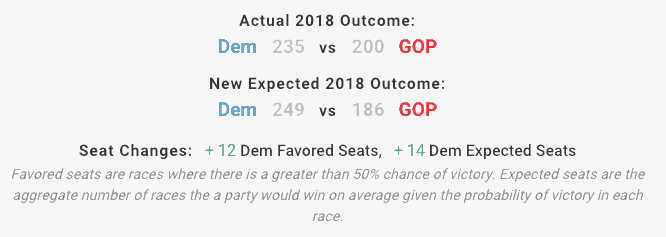When we introduced the 2018 Election Forecasting Simulator yesterday, we included several different scenarios to play around with. Today we’re taking a look at one in particular, which maximizes the expected number of Democratic victories in the House. How many seats did they leave on the table? As it turns out, not all that many.
Democrats were able to pick up 40 seats in the House, winning a total of 235 seats. If you keep GOP money constant (more on this later) and re-allocate Democratic money based not on polling, loyalty, or strategic intuition, and instead assign $10,000 chunks to the race whose probability of victory increases the most with that chunk, you’re able to increase the expected Democratic victories by 14, to 249 seats.

The full list of changes is available in our Scenario Report page.
A couple of big caveats here. First, this assumes no shift in GOP money, which is not the way the chess match plays out in reality. If Democrats don’t spend money in a particular race, Republicans probably will spend less money there, too. And if there’s a race with no independent expenditures on either side, and Democrats all of a sudden pour 10 million dollars in, Republicans will counter that, removing money from other races in the process. Also, these changes are based on pre-election probabilities, so there will be some races that money is re-allocated without knowledge of actual results. Why does this matter? It will give up on some races that we had Democrats as underdogs in, even though they won in reality. For instance, it removes all money from FL-26, a race that Democrats won by a small margin- and we’d probably prefer to win it at that point than give up on it and re-allocate elsewhere.
Think you can do a better job and get Democrats to a huge victory while accounting for those two caveats? Jump into “Both Parties” mode, play out the true chess match, and share the report with us on Twitter (@0ptimusPredicts). We may feature it as a default scenario (and include your name, if you’d like)!